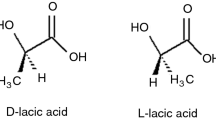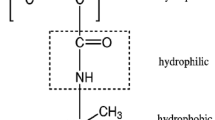Abstract
We directly observed the polymerization and crystallization of polyamide 6 (PA6) via anionic polymerization with a combination of in situ wide-angle X-ray scattering (WAXS), temperature measurements, and real-time visualization. In situ WAXS discriminated polymerization and the crystallization of PA6. The peak temperatures produced by exothermic polymerization and crystallization were identified during the temperature measurements. Visual observations were consistent with the WAXS spectral changes. The WAXS results indicated that the molding process consisted of three stages: (1) polymerization induction, (2) polymerization, and (3) crystallization. We compared the polymerization rate, crystallization rate, and crystallinity at each molding temperature. Both polymerization and crystallization were slow at temperatures below 127 °C. Polymerization was fast at temperatures exceeding 166 °C, but PA6 was gelated, and the crystallization rate and crystallinity were low. In contrast, polymerization was fast at 139, 148, and 155 °C, and crystallization was faster at 148 and 155 °C than at 139 °C. Therefore, the total molding time of PA6 was shorter at 148 and 155 °C than at other temperatures. The crystallinity of PA6 decreased with increasing temperature due to increasing molecular weights. We concluded that molding temperatures between 148 and 155 °C were suitable for providing PA6 with high productivities and good properties.









Similar content being viewed by others
References
Roda J. Polyamides. In: Dubois P, Coulembier O, Raquez JM, editors. Handbook of ring-opening polymerization. Weinheim: Wiley-VCH Verlag; 2009, p. 165–81.
Bitterlich M. Tailored to reactive polyamide 6. Kunstst Int. 2014;3:47–51. https://www.kunststoffe.de/en/journal/archive/article/tailored-to-reactive-polyamide-6-814047.html. Accessed 17 Apr 2019.
Wilfong DL, Pommerening CA, Gardlund ZG. Separation of polymerization and crystallization processes for nylon-6. Polymer. 1992;33:3884–8.
Khodabakhshi K, Gilbert M, Dickens P. Monitoring of small scale anionic polymerization of caprolactam: a method to be used in an additive manufacturing process. Polym Adv Technol. 2013;24:503–10.
Sibal PW, Camargo RE, Macosko CW. Designing nylon-6 polymerization systems for RIM. Polym Process Eng. 1983;1:147–69.
Davé RS, Kruse RL, Stebbins LR, Udipi K. Polyamides from lactams via anionic ring-opening polymerization: 2. kinetics. Polymer. 1997;38:939–47.
Ramesh C, Gowd EB. High-temperature X-ray diffraction studies on the crystalline transitions in the α- and γ-forms of nylon-6. Macromolecules. 2001;34:3308–13.
Van Rijswij K, Bersee HEN, Jager WF, Picken SJ. Optimisation of anionic polyamide-6 for vacuum infusion of thermoplastic composites: choice of activator and initiator. Compos, Part A. 2006;37:949–56.
Van Rijswij K, Bersee HEN, Beukers A, Picken SJ, Van Geenen AA. Optimisation of anionic polyamide-6 for vacuum infusion of thermoplastic composites: influence of polymerisation temperature on matrix properties. Polym Test. 2006;25:392–404.
Ricco L, Russo S, Orefice G, Riva F. Anionic poly(ε-caprolactam): relationships among conditions of synthesis, chain regularity, reticular order, and polymorphism. Macromolecules. 1999;32:7726–31.
Murthy NS, Curran SA, Aharoni SM, Minor H. Premelting crystalline relaxations and phase transitions in nylon 6 and 6,6. Macromolecules. 1991;24:3215–20.
Magill JH. Crystallization kinetics study of nylon 6. Polymer. 1962;3:655–64.
Acknowledgements
The authors would like to thank Mr Chisao Hayashi and Mr Masao Tsuji at the Toyota Central R&D Labs and Prof. Kenzo Fukumori at the Aichi Institute of Technology for their valuable input. The synchrotron radiation experiments were performed on the BL33XU line at SPring-8 with the approval of the Japan Synchrotron Radiation Research Institute (JASRI) (Proposal Nos. 2016A7003 and 2016B7003).
Author information
Authors and Affiliations
Corresponding author
Ethics declarations
Conflict of interest
The authors declare that they have no conflict of interest.
Additional information
Publisher’s note Springer Nature remains neutral with regard to jurisdictional claims in published maps and institutional affiliations.
Supplementary information
Rights and permissions
About this article
Cite this article
Narita, M., Yoneyama, H., Matsunaga, T. et al. Simultaneous study of anionic polymerization of ε-caprolactam and crystallization of polyamide 6 in an isothermal process by in situ WAXS. Polym J 52, 199–206 (2020). https://doi.org/10.1038/s41428-019-0262-8
Received:
Revised:
Accepted:
Published:
Issue Date:
DOI: https://doi.org/10.1038/s41428-019-0262-8
- Springer Nature Limited




